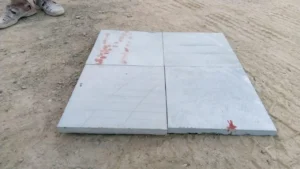Is Kota Stone Acid Proof?
Kota stone, a type of fine-grained limestone, is quarried from the Kota district of Rajasthan, India. It’s widely used in various construction projects due to its durability, non-slippery texture, and natural beauty. However, one question that often arises among architects, builders, and homeowners is about its resistance to acid: Is Kota stone acid proof?
Understanding Acid Resistance
Acid resistance in building materials is crucial, especially for surfaces exposed to substances that can cause erosion or damage. This is particularly important for flooring, countertops, and outdoor applications where the material might come into contact with acidic rain, spills, or industrial chemicals.
Kota Stone’s Composition and Characteristics
Kota stone is primarily composed of calcite (calcium carbonate), which inherently reacts with acids. When an acid comes into contact with calcite, a chemical reaction occurs, leading to the dissolution of calcium carbonate. This reaction is not only characteristic of Kota stone but of all limestone-based materials.
Practical Insights on Acid Exposure
In practical terms, this means that Kota stone is not acid-proof. Exposure to strong acids like sulfuric acid, hydrochloric acid, or even milder acidic substances like vinegar or citrus juice can cause etching, dulling the surface’s finish, or even creating pits over time. This is a critical consideration for areas prone to acid exposure.
Mitigating Acid Damage
While Kota stone may not be inherently acid-proof, certain measures can mitigate its susceptibility to acid damage:
Sealing: Applying a high-quality penetrating sealer can provide a protective barrier that reduces the stone’s porosity, making it more resistant to acid spills. It’s important to choose a sealer suitable for Kota stone and to reapply it periodically based on the manufacturer’s recommendations.
Prompt Cleaning: In case of acid spillage, immediate cleaning can prevent or minimize damage. It’s advisable to blot spills gently rather than wiping them to avoid spreading the acid.
Maintenance and Care: Regular maintenance, including cleaning with pH-neutral cleaners and avoiding abrasive materials, can help preserve Kota stone’s integrity and appearance.
Conclusion
Kota stone, while esteemed for its beauty and durability, is not acid-proof. Its calcium carbonate composition renders it vulnerable to acid-induced erosion. However, with proper sealing, prompt action against spills, and regular maintenance, the effects of acid exposure can be significantly minimized, extending the life and preserving the beauty of Kota stone installations. When selecting materials for areas expected to face acid exposure, it’s vital to consider these factors to ensure the longevity and maintenance of the aesthetic appeal of the construction material.

